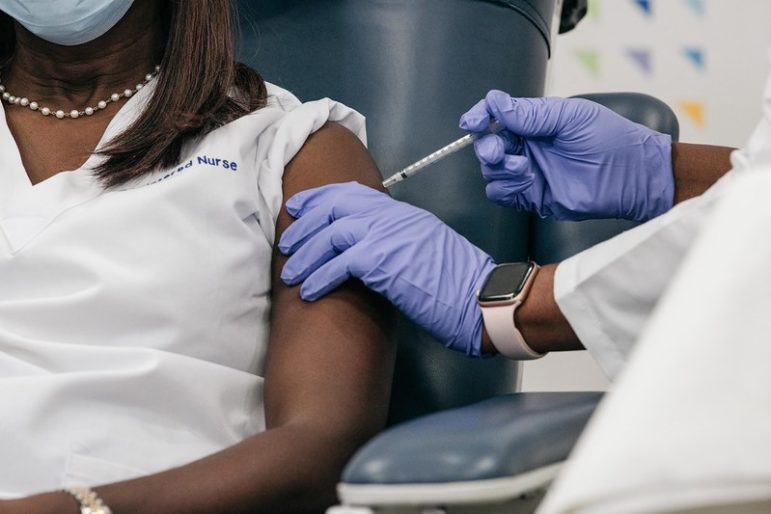‘When vulnerable populations were reluctant to participate in the census, the city and state spent tens of millions of dollars on public outreach and education. They should use the same playbook now to fund initiatives that disseminate information about vaccine efficacy and safety.’

Scott Heins for the Office of Governor Andrew M. Cuomo
A healthcare worker received the first dose of the COVID-19 vaccine in New York on Dec. 14.Racial disparities continue to be a defining characteristic of the COVID-19 pandemic in New York City. According to recent city data, Black and Latino New Yorkers have been vaccinated at much lower rates than white residents, despite suffering a disproportionate share of infections, illnesses, and deaths.
These harsh realities correlate with other health inequities. In 2020, the Bronx – which has experienced the highest rates of COVID-19 hospitalizations and death per capita across the five boroughs – once again ranked last of New York State’s 62 counties for overall health outcomes.
The good news is that government on all levels has taken steps recently to make vaccines more accessible in communities where they are needed most. The Biden administration’s Community Health Center Vaccination program promises to ensure that vaccines are distributed more equitably. Meanwhile, the city and state have opened more vaccination centers in neighborhoods where the majority of residents are people of color and, importantly, are prioritizing local residents for appointments. These efforts, along with overall increases in vaccine allocation, should improve access going forward, although additional work is still needed to make the vaccine even more accessible, such as mobile units and vaccine sites embedded in churches, community centers, schools and other places where people regularly gather.
 CityViews are readers’ opinions, not those of City Limits. Add your voice today!
CityViews are readers’ opinions, not those of City Limits. Add your voice today!
But access alone won’t ensure that vaccination rates among Black and Latino New Yorkers rise to levels that will turn the tide against the pandemic in hard-hit communities – and our city at large – as quickly as we all want. The truth is, vaccination hesitancy persists in these communities, stemming from mistrust of government and healthcare systems, the prevalence of misinformation, and inequities in healthcare access.
We see it firsthand at the Women’s Housing and Economic Development Corporation (WHEDco), a nonprofit that provides housing, education, and other community building services to Black and Latino families in the South Bronx. Many of those served by WHEDco have told us they are reluctant to be vaccinated or do not plan to be vaccinated at all. We have also seen hesitancy among staff members, the majority of whom are people of color.
In response, we partnered to roll out an education initiative on a small scale, hosting virtual vaccine education workshops in English and Spanish for both WHEDco staff and individuals and families in our programs. Since some of the families we serve may not have a relationship with a primary care doctor, connecting them to a medical professional from their own community (Dr. Morales was born and raised in the Bronx), who can listen and respond to their questions and concerns in a safe space and in their own language has been critical to our efforts to build confidence in the vaccine in our community.
Government has a vital role in addressing this obstacle on a much larger scale, in partnership with community-based organizations like WHEDco. Last year, when vulnerable populations were reluctant to participate in the census, the city and state spent tens of millions of dollars on public outreach and education. They should use the same playbook now to fund initiatives that disseminate information about vaccine efficacy and safety – as well as how to sign-up for an appointment – in communities of color. If census education was important enough to invest tens of millions of dollars, isn’t the vaccination effort worth it as well?
With government funding, community organizations like WHEDco could ramp up vaccine education efforts, in partnership with medical professionals, and convince more New Yorkers – particularly in hard-hit neighborhoods – to get vaccinated. Organizations like ours are effective messengers because we have been on the ground, building trust over many years with the people we serve. Our families know they can rely on us to advocate for their interests and provide needed resources – including important, accurate information.
The timing is urgent. As a city, we should want everyone – especially those who are most vulnerable – to get vaccinated as soon as they are eligible, which means ensuring they have all the necessary facts and know how to access the vaccine by the time it’s their turn. Otherwise, unused doses may sit on shelves while millions remain unprotected, keeping herd immunity out of reach and prolonging the pandemic and all of the suffering that comes with it.
Davon Russell is the President of WHEDco. Susana Morales, MD is a primary care physician at Weill Cornell/New York Presbyterian, Associate Professor of Clinical Medicine at Weill Cornell Medical College and the Principal Investigator of Weill Cornell’s Diversity Center of Excellence.









One thought on “Opinion: NY’s Vaccine Plan Must Include Education, Similar to Census Outreach”
With physical distancing, “outreach” is tricky. Person-to-person contact is barely on the menu. I was pleased to read vaccines are or will be available at some NYCHA sites. People will see their neighbors getting vaccinated. This will help boost acceptance. Perhaps these same NYCHA sites can assist making vaccine appointments both for those with limited connectivity and for those who are reluctant. Staying on this topic, I think asking vaccine recipients at NYCHA sites why they chose to be vaccinated — and then using that guidance to encourage those decisions — is the best way to get at vaccine resistance or avoidance.